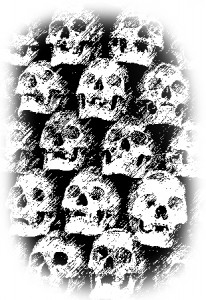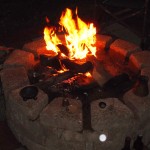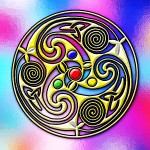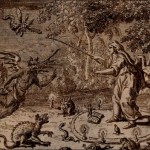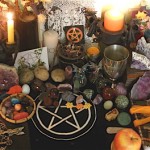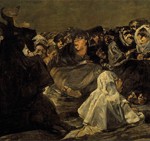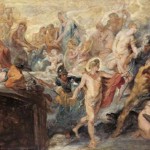New readers should understand that I’m an odd fellow, even as Pagans go. My interests often center on the practice of Pagan religion – public liturgy and ritual, home shrines, meditation, invocation, etc. However I am equally concerned 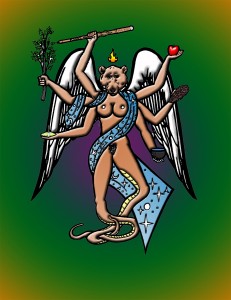 with occultism, magical arts and the practice of magic and sorcery. I have read extensively in a lot of occult schools, and have always had an important secondary interest in the western grimoire-magic tradition. Eventually I’ll relink my articles on adapting grimoire magic for a polytheist myth-setting. There’s always discussion in Blog-land on the topic of ‘demons’, and on their relation to the idea of ‘daemons’. I find the Hellenic category daemon to be a useful way of understanding the general category of ‘spirits’ in a Pagan sense.
with occultism, magical arts and the practice of magic and sorcery. I have read extensively in a lot of occult schools, and have always had an important secondary interest in the western grimoire-magic tradition. Eventually I’ll relink my articles on adapting grimoire magic for a polytheist myth-setting. There’s always discussion in Blog-land on the topic of ‘demons’, and on their relation to the idea of ‘daemons’. I find the Hellenic category daemon to be a useful way of understanding the general category of ‘spirits’ in a Pagan sense.
In that sense, I understand Hellenic ‘daimons’ (or daemons – I probably won’t be consistent) to be spirits of almost every type, up to and including the Olympians themselves and down to the smallest pool-sprite or Cloacan imp. In Hellenic religion these were understood as servants, messengers or persons of the gods, or as active on their own. Members of the mortal Dead might become daimons. One important function of daemones was to carry sacrifices to the gods themselves, and to return with their blessing. These spirits became associated with the rites and tools of domestic and civic cults – the ‘familiars’ of the sacrificers, the ‘genii’ – which means, at base, ‘family spirits’.
In any animist or spiritist system it will be plain that not all spirits are safe, easy or friendly. The Greeks distinguished between eudaimones and kakodaimones – ‘pretty’ spirits and ‘shitty’ spirits, rather literally. Yes, Virginia, there are fairies in the dung… The spirits of rot and decay, so mandatory for the management of a forest floor, become less welcome in human habitation. If there is a daimon in the waterfall, or in the corn, there is surely one in cholera or crib-death as well. Some parts of lovely and holy nature will just plain kill yer butt – the spirits of those parts are often thought of as ‘wrathful’ or even as ‘demons’. In traditional cultures it is often the task of priests and magicians to manage them.
Then there is the issue of moral dualism. I do not believe that there is a spiritual battle between Good and Evil. The spirits are not lining up into skins versus… other people’s skins… Just like mortals, the spirits go about their business- waterfalls fall water, cholera eats and kills, etc. It does make sense for mortals to divide our attentions between spirits who benefit us and spirits who might harm us. We do as much with animals, plants and landscapes. Many dangerous, powerful things make good allies, even gods.
That brings us to operative magic in a traditional European model. The usual powering agencies behind the magic of the Greek Papyri are the daemones, whether of the gods invoked in the rite, or sometimes in general, and sometimes as categories of the Dead. These spirits are tasked with the usual goals of love-spells, revenge, legal cases and sports-betting.
As the Hellenic moral sense became more restrictive (or refined, as you like) theorists began to assert that some daemones became ‘base’ in their desires and inclinations. They hung around boxing-matches, low sport and Underworld sacrifices. As they became base so the mortals they influenced became more inclined to vicious behavior. These spirits became the servants of low sorcerers, essentially thug-spooks for hire. This was not all so much based upon a matter of ‘sin’ as it was on the idea that wallowing in dung makes one stink. (Back to kakodaemones…). Magicians (especially theurgists) proposed that virtuous living supported contact with wiser, calmer, spirits long before Christian dualism developed its spirit hierarchies.
I remain interested in how the Book of Enoch’s notion of ‘fallen angels’ got wrapped up in all of this. Of course we see there the same pattern – divine beings attracted by earthly delights. One Hellenic notion of the origin of the daemones is that they are the souls of the humans of the Golden Age, ennobled by the gods to act as guardians and aids for mortals. Throw in the jealousy of the God of Sinai, and those noble spirits become rebellious angels. To the Hellenes and other Indo-European Pagans, the siring of children with mortal women by mighty spirits was neither improper nor unclean. The spirits of such children often became mighty daimones.
As the classical era ends, Paganism slowly becomes illegal in the Roman Empire. Pagan rites are transferred from the public temples to private chapels and living-rooms. In these reduced circumstances we may have the beginnings of ‘high magic’, and certainly of later theurgy. It is from rites of this sort combined with the low magic of the Greek Papyri that the magic of the grimoires is thought to spring, long and winding though the trail from 700 to 1700 may be.
As Christian myth and spiritology became the norm among scholastics (and so among magicians) the base daemons were reckoned part of the Enemy’s legions and called ‘demons’, while better daemons were assigned to heavenly quires to become ‘angels’ – messengers – of ‘God’. The whole War In Heaven myth is applied, God’s Kingdom opposed to the World, the Flesh and the Devil. The material world being part of the unholy triad of primal Christian thought – any spirit not immediately part of the angelic hosts was a ‘demon’ – a subject of the Prince of This World. So elementals, ‘fairies’ – the worldly end of the spiritual hierarchy were considered ‘demons’ by medieval magic.
Among magicians, who were always less than orthodox, the spiritual hierarchy began at an archangel (or a ‘god’ in earlier and later material), descending through layers of servitor spirits. The very lowest layer of those servitor spirits – the actual workers of the magician’s team – were often called ‘demons’. In one of the classical models of spirit-arte demons are commanded by the magician through the agency of the names of the proper ruling angels. In this way the sovereignty of the system’s ‘God’ is preserved, while putting power into the magician’s hands.
We arrive at the era of the famous grimoires with lists of spirits that are known to serve magicians. Some of them seem to be reflections of specific ancient gods, others are more obscure. Some actually do things like slay and coerce, but many create gardens or teach mathematics. If one reads the list of ‘demons’ in, e.g. the Goetia of the Lesser Key one hardly gets the impression of seething evil, disease and revolt. My favorite mythic-style guess is that those spirits began as daemons serving the Gods at the sacrifices, and continued to answer the calls of magicians over the centuries. After all, some sources say that spirits change their names every 40 years…
For many modern magicians approaching the daemones remembered in the early-modern grimoires is a matter of practicality and mechanics. Most grimoire rites involve no diabolism, no worship of Christian mythic figures such as Satan and Lucifer. Rather the piety and focus of the magician on the divine however it is understood allow him to deal with the spirits. The very latest revisions of grimoire ritualism have added a respectful relationship of alliance with these daemones, which seems reasonable to me.
My own opinion is that we can safely discard the whole separation of spirits into ‘angels and demons’. If one prefers to consider spirits who function specifically as ‘messengers’ of a god to be angels, that’s linguistically sensible. There isn’t really much use for ‘demon’ unless one uses it as shorthand for ‘wrathful, dangerous or predatory spirit’. I didn’t mention the idea of spirits who deliberately set themselves against humankind as our enemies, because I’m unsure that such things exist.
As someone concerned with Celtic and Germanic magic I have no real resonance with the spirit-lists of the early-modern grimoires. I gave some thought to attempting to work with them inside our Druidic fire-sacrifice ritual form. In the end I took the route of prospecting for new spirits. I have no dog in the fight over whether the spirits of the Lesser Key (or of other goetic grimoires) are more dangerous than useful. However, useful things are often dangerous, and I would never advise magicians to play things entirely safe.

